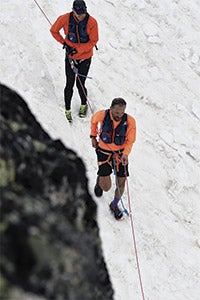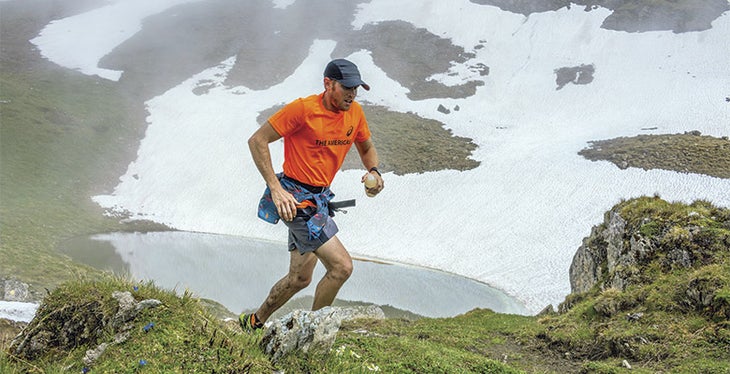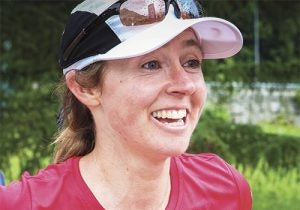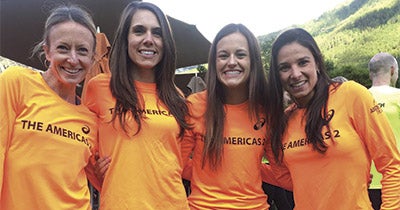New perk! Get after it with local recommendations just for you. Discover nearby events, routes out your door, and hidden gems when you sign up for the Local Running Drop.
It had all the ingredients of an epic novel: America’s two all-time best marathoners taking on foes they have never faced. They struggled against dirt, altitude and extremely technical terrain, all with a team dependent on their results and a clock ticking down to zero. Would the heroes succeed?
The setting was the recent third running of the Asics Beat the Sun race, a 140-kilometer relay event around the Mont Blanc massif through France, Italy and Switzerland. The heroes were two Olympians, 43-year-old Deena Kastor, of Mammoth Lakes, California, and 33-year-old Ryan Hall, of Redding, California. Both hold American records in the marathon and half-marathon, and Kastor has gone on to set five world records as a masters runner.
Eight teams from across the world made up of six athletes each—three elites and three amateurs—had 15 hours 41 minutes (from sunup to sundown) to finish the course on the summer solstice, the longest day of the year. Asics hand picked the competitors, a mixture of the company’s sponsored elites and amateurs who applied and used social-media voting to help shore up their odds for selection. Teams hailed from the Americas, Europe, East Asia, Oceania-Pacific and South Africa.
Each athlete completed either two or three legs of the course. Hall and Kastor landed on the same team, one of two from the Americas. Their team was rounded out by elite Brazilian trail runner Iaza Feitoza and three amateur females. When all was said and done, the team may not have beaten the sun, but Kastor and Hall walked away with an entirely new appreciation for trail and mountain running.

Deena Does Dirt
Kastor, who won a bronze medal in the 2004 Athens Olympics, and holds the American marathon and half-marathon records, joined the race through her husband, Andrew, an Asics coach brought on board to guide the team’s training.
“When Andrew decided to be part of this, I said I’d love to go along,” she explains. “Before I knew it, I was signing on, so a fun time for my husband turned into a race for me, too.”
It was the prospect of trying something new that really drew her in, she says. “This type of challenge is exactly why I haven’t retired yet,” says the Olympian. “I got to challenge my positivity as well as my ability to run trails.”
To prepare for the race, Kastor spent two months training off road and on big climbs. Living at about 8,000 feet made altitude training convenient. Two-hour long runs in the hills combined with specific hill training designed by Andrew got her primed for Mont Blanc.
Still, Kastor didn’t know which legs of the race she’d be running until just a few days before the event. As part of the competition’s unique format, the race director, Laurent Adito, determines who will run which section. He pegged Kastor for legs one, six and 12 for a total of 34K. This matched Kastor up with other elites including trail superstar Megan Kimmel, 35, of Ridgway, Colorado.
“I think part of the challenge was not knowing which legs I would have in advance,” Kastor says. “When I arrived in Chamonix, I discovered that the trails were much more technical than I expected, with more downhill. I thought I was going to be running fairly flat legs based on the descriptions.”
Kastor’s first leg, from Chamonix to Le Tour, included about 1,300 feet of climbing. Leg six, from Arnuva, began at 5,800 feet and dropped down to 4,035 feet at Courmayeur. Her final leg, back into Chamonix, involved only a small amount of elevation change over a rolling course.
One of the biggest lessons learned, says Kastor, is that trail runners and road runners differ in opinion on what is considered rolling or flat. She began to get a picture of this on the training runs a few days leading up to the event. “We have entirely different perceptions of climbs,” she says.
With that gap between expectations and reality, Kastor says she took her first leg out pretty hard. “When I finished that leg, I knew I had to concentrate on recovery so that I would have something left for the other two legs,” she explains. “As soon as I finished, I ate, showered and took a nap.”
On Kastor’s final leg, she found herself running near Kimmel, jockeying for position as both Team Americas fought to stay ahead of the sun. “There was a bit of smack talk when we were waiting at the checkpoint for our runners,” she says, laughing. “When it became clear we weren’t going to beat the sun, we relaxed and ran it in together.”
This gave Kastor a deep appreciation for the skills of Kimmel. “I was in awe at how beautifully she handled trails,” she says. “She didn’t break stride for anything. It’s no wonder she has accomplished what she has.”
Kimmel had mutual admiration for Kastor. “She didn’t need my advice out there,” she says. “She was just fine.”
Kastor says the race experience served as a crash course in trail running. “I learned so much about the technicality of trails,” she explains. “It was very challenging to push hard in those conditions.”
In the week following the race, Kastor didn’t run a step, instead concentrating on recovery. “I’ve never been this sore after a marathon,” she says. “Every part of my body hurt.”
When asked if she’d return in 2017 if invited, Kastor answered with an enthusiastic “yes.” “This definitely whetted my appetite for more trail running,” she says. “And if I go back, I’ll have a better idea of how to prepare.”

Hall Rediscovers His Love of Running
Between his retirement in January 2016 and that April, Hall didn’t run much more than 12 miles per week. Fatigued and fighting to find the motivation to train, Hall has spent much of the year helping his wife, Sara, prepare for the Olympic Trials. His personal focus switched to weight training, becoming a new father to four daughters adopted from Ethiopia and taking a mental break from any sort of regimen.
The prospect of the trail relay, however, rekindled his passion for running. “I needed an inspiring event to get back into it,” he says. “For me, going up into the mountains is exciting.”
Doing so allowed Hall to return to his roots as he first began running as a kid in the mountains of California. He admits, however, that his prep for the event fell short. “I had these grandiose plans of running lots of big trails,” he says. “But I did much of my running with Sara, who needs to be on flatter, faster roads.”
It turns out Hall had to face two of the race’s toughest legs, numbers three and seven. The first involved a high-mountain section topping out at 8,200 feet and a large snowfield, followed by a steep descent on technical singletrack into Champex, Switzerland. Each of the elites assigned this leg did so with a partner, Hall’s being Feitoza.
It was during this leg that Hall had to pull out his trekking poles for the first time. “I was going through this mental battle about using the poles, thinking it made me wimpy if I needed them,” he says. “But once I started using them, I realized how much easier it was.”
Hall found he felt fresh and fast on his first leg. “We flew down the descent, hitting a 5:02 or 5:05 [mile] at one point,” he says. “We made up a ton of time on other teams there.”

Not so much on the second leg, however, where Hall began to feel the fatigue of the first. This leg involved a last-minute course change due to heavy precipitation. It originally would have involved harnessing in and wearing a helmet to cross a rock face, but still proved incredibly challenging to the mountain-running newbie. “On leg seven, I didn’t have my poles but found myself wishing I had,” he explains. “We got worked over by everyone, because I was really tired at that point.”
For Hall, whose speed on the roads means he’s never run longer than about two-and-a-half hours at a stretch, the combined four hours on his feet took its toll. “I’ve never gone hard for that long,” he says. “That, the power walking and the technical aspect of the trails were the toughest parts for me. I felt like a creaky old man on some of those descents.”
Hall’s takeaway is that to some extent, unless you live in mountains like those around Mont Blanc, it’s nearly impossible to be fully prepared for a race like Beat the Sun. “One of the guys who trains there was just killing it,” he says.
Similar to Kastor, Hall found he was more sore than his usual post-race experience. “Energy-wise I was O.K., I think because my heart rate stayed nice and low throughout the race,” he says. “But my quads were sore for several days after.”

Both Hall and Kastor say the team aspect of the challenge served as extra incentive to work hard on the unfamiliar terrain. “It is special,” says Hall. “When you think about your teammates out there, it keeps you from caving in when you’re so tired.”
Kastor agrees. “You form immediate friendships when you put like-minded people together,” she says. “You want to do your best for them.”
Hall says that while he “ate a nice piece of humble pie” at the race, he gets why trail runners go back over and over again. “You get to run in beautiful, inspiring places,” he says. “I’d love to go back and improve on this year.”

Kimmel Makes it a Three-Peat
While the Beat the Sun race featured a wide variety of elite athletes—an Olympic speed skater and an Ironman champ among them—it also included several seasoned trail-running pros. Megan Kimmel (left), a three-time member of the U.S. Mountain Running Team and past winner of the Moab Trail Marathon, came into the race as the veteran of the field, taking on her third trip around Mont Blanc.
This year, Kimmel’s Team Americas 1 finished hand-in-hand with Team Americas 2, both an hour behind the sun. Kimmel herself ran three legs, totaling close to 19 miles, head-to-head with Deena Kastor.
Kimmel’s results in 2015 and 2014 were much different, however. In the race’s 2014 debut, she was part of a contest between two teams made up entirely of elites. Her team beat the sun’s cutoff by a mere 33 seconds. Returning in 2015 with a race format of five mixed amateur-elite teams, Kimmel helped her team win the event, beating a fast-chasing European team by just four seconds.
This year, the course proved more challenging, as it reversed directions from years past and also included far more snow than in earlier iterations. “Certainly this course was designed to boost the challenge of beating the sun and without a doubt the trail conditions made it very difficult,” says Kimmel. “Also, the weather was not as good as the years past, with rain and snow on a couple of the legs.”
While Kimmel’s team wasn’t in the mix for the win this year, she says she enjoyed the event for other reasons. “Running the last leg with Deena was a nice change from the intensity of beating the sun,” she says. “The highlight for me this year was simply enjoying the challenge with even more great people.”

The Amateurs
This year’s Beat the Sun race afforded 48 amateurs from all over the globe the chance to toe the line as teammates with some of the world’s best. Asics selected the lucky runners based on a combination of their running resumes, backstories and social-media chops.
The six amateurs who rounded out the two Team Americas teams each brought impressive backgrounds to the table. They included three runners from the States, and one each from Brazil, Canada and Argentina.
Each of the amateurs ran two legs varying in distance from 6K to 19K, often including major climbs, the biggest of which totaled 1,000 feet and the highest of which hit 8,775 feet. All but one successfully completed their legs—one suffered a knee injury on her first leg and chose to swap her remaining leg with an alternate runner.
Kastor, part of Team Americas 2, says that while this group was dubbed “amateur,” the runners were anything but. “They were all so savvy and had so much grit,” she says. “They knew what they were doing and everyone brought their A game.”